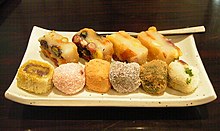Tteok (Korean: 떡) is a general term for Korean rice cakes. They are made with steamed flour of various grains,[1] especially glutinous and non-glutinous rice. Steamed flour can also be pounded, shaped, or pan-fried to make tteok. In some cases, tteok is pounded from cooked grains.
 | |
| Alternative names | Rice cake |
|---|---|
| Type | Rice cake |
| Place of origin | Korea |
| Main ingredients | Flour made of various grains, including glutinous or non-glutinous rice |
| Variations | Steamed, pounded, shaped, pan-fried |
| Korean name | |
| Hangul | 떡 |
|---|---|
| Revised Romanization | tteok |
| McCune–Reischauer | ttŏk |
| IPA | [t͈ʌk̚] |
Tteok is eaten not only as a dessert or seasonal delicacy, but also as a meal. It can range from elaborate versions made of various colors, fragrances, and shapes using nuts, fruits, flowers, and namul (herbs/wild greens), to plain white rice tteok used in home cooking. Some common ingredients for many kinds of tteok are red bean, soybean, mung bean, mugwort, pumpkin, chestnut, pine nut, jujube, dried fruits, sesame seeds and oil, and honey.
Tteok is usually shared. Tteok offered to spirits is called boktteok ("good fortune rice cake") and shared with neighbours and relatives. It is also one of the celebratory foods used in banquets, rites, and various festive events. Tteokguk ("rice cake soup") is shared to celebrate Korean New Year and songpyeon is shared on Chuseok, a harvest festival.
The history of rice cakes goes back to the primitive agricultural society. It is presumed that it is because at least about the 7th to 8th centuries B.C., there are records of sowing seeds and plowing and farming in this land, or because almost all of them are found in the ruins like Galdol (a flat stone used as a tool when grinding fruit against a grind stone) or Dolhwag (a small mortar made of stone) of that period.[2]
The origin of rice cakes began in prehistoric times when the coarse powder obtained from the primitive threshing process of multigrains was baked without cooking utensils or by making earthquake foods.[3]
Below are cooking utensils used to make tteok in the traditional Korean way.[4]
Tteok is largely divided into four categories: "steamed tteok" (찌는 떡), "pounded tteok" (치는 떡), "boiled tteok" (삶는 떡) and "pan-fried tteok" (지지는 떡). The steamed tteok is made by steaming rice or glutinous rice flour in "siru" (시루), or a large earthenware steamer, so it is often called "sirutteok" (시루떡). It is regarded as the basic and oldest form of tteok. Pounded tteok is made by using a pounding board or mortar after steaming it first. In making pan-fried tteok, the rice dough is flattened like a pancake and pan-fried with vegetable oil. Shaped tteok are made by kneading dough with hot water, then shaping it into balls.[5]
The main ingredients for steamed tteokor"sirutteok" are rice (멥쌀, mebssal in Korean) or glutinous rice (찹쌀 chapssal), and sometimes they are mixed together. In some cases, other grains, beans (azuki beansormung beans), sesame seeds, wheat flour, or starch are mixed with the rice. Various fruits and nuts are used as subsidiary ingredients, such as persimmons, peachesorapricots, chestnuts, walnuts, and pine nuts. In addition, marinated vegetables or herbs can be used to flavor the tteok. Danggwi leaves (Ostericum grosseserratum), seogi mushroom (manna lichen), radish, artemisia, pepper, and cheongju are the most common flavorings, and honey and sugar are used as sweeteners.[5]
In order to make steamed tteokorsirutteok, rice or glutinous rice is soaked in water for a while, then ground. The prepared rice flour is put in a siru and steamed. According to steaming method, sirutteok is subdivided into two groups: seolgitteok (설기떡), which is shaped into a single large lump, and kyeotteok (켜떡), which consists of multiple layers with adzuki bean powder or other bean powder. Seolgitteok is also called muritteok (무리떡), which is regarded as the most basic form of sirutteok because it is made only of rice. When making kyeotteok, rice and glutinous rice are mixed. The name kyeotteok derives from the adverb kyeokeyo (켜켜, literally "layered") in Korean because this tteok is made in layers.[5]
In traditional preparations, pounded tteok is made by pounding rice or glutinous rice with utensils called jeolgu and jeolgutgongiortteokme and anban. Injeolmi (tteok coated with adzuki bean powder or roasted soybean powder), garaetteok (가래떡 cylinder-shaped white tteok), jeolpyeon (절편 patterned tteok) and danja (단자 glutinous tteok ball coated with bean paste)” are the most commonly eaten pounded tteok.[citation needed]
Rice and glutinous rice are hulled to make grain particles or powder and then steamed in a siru (earthenware steamer) and pounded with utensils. The pounded tteok is divided by rice type into glutinous pounded tteok (찹쌀도병 chapssal dobyeong) and non-glutinous pounded tteok (맵쌀도병 mapssal dobyeong). Injeolmi, a representative of glutinous pounded tteok, varies in accordance with gomul types (고물, coating made with bean powder, sesame seeds, or sliced jujubes) or subsidiary ingredients mixed into the steamed rice while pounding on the anban. Patinjeolmi (팥인절미), and kkaeinjeolmi (깨인절미) are examples for the former, coated with red bean powder and sesame, respectively. In ssuk injeolmi (쑥인절미) and surichwi injeolmi (수리취인절미), ssuk (Artemisia indica) and surichwi (Synurus deltoides (AIT.) NAKAI) are added.[5]